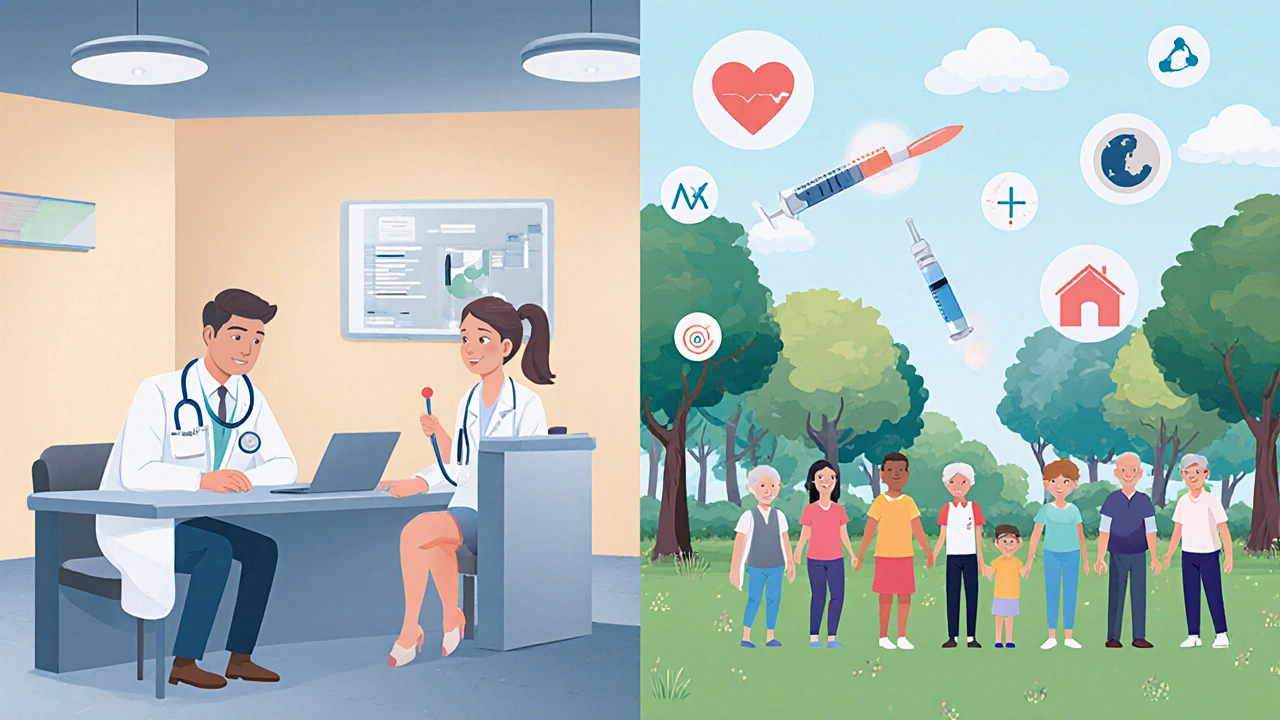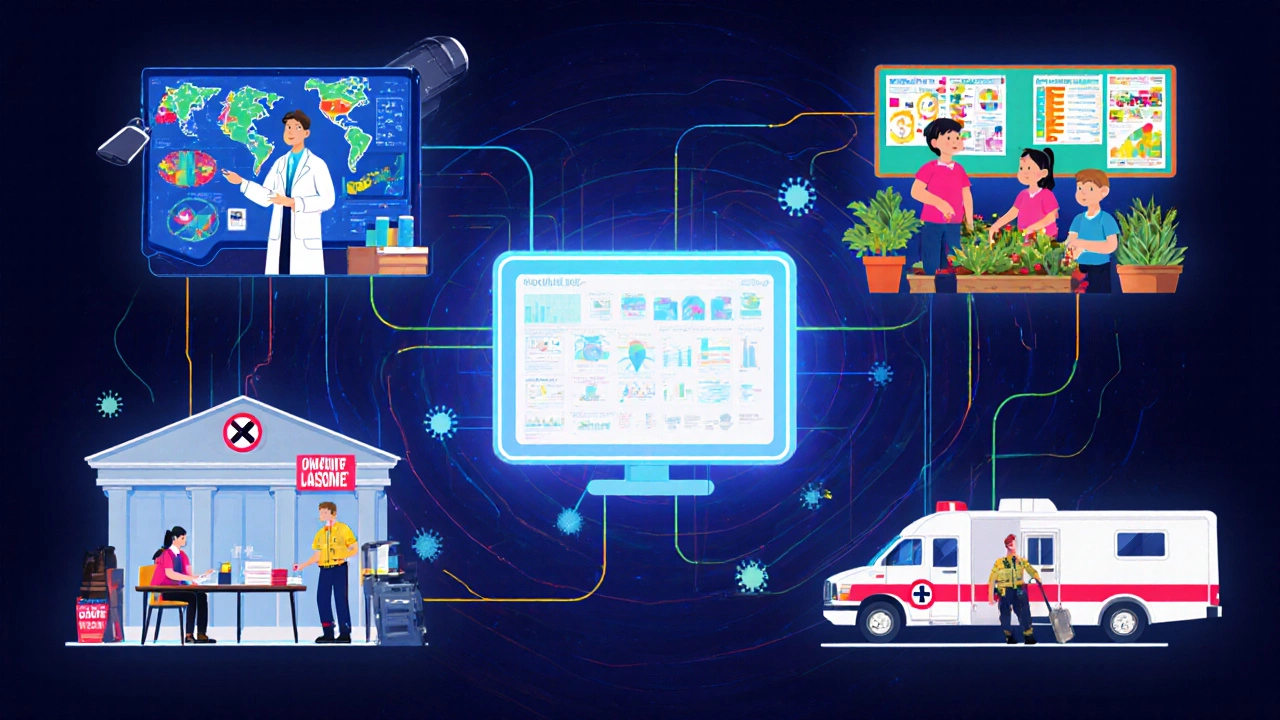Public Health Approach to Healthcare Explained
 Oct, 24 2025
Oct, 24 2025
Public Health Cost-Benefit Calculator
Calculate Public Health Impact
Understand the value of public health interventions by comparing costs against potential health outcomes and financial savings.
When you walk into a clinic you expect a doctor to treat your cold, break a bone, or prescribe medication. But the biggest health threats-like obesity, heart disease, or pandemics-aren’t solved one patient at a time. That’s where the public health approach steps in, shifting the focus from treating illness to keeping whole populations healthy.
What exactly is the public health approach?
Public health approach is a systematic way of improving health outcomes by acting on the root causes that affect groups of people rather than isolated individuals. It blends science, policy, and community action to prevent disease, promote well‑being, and reduce health inequities.
Core principles that drive the approach
- Prevention first: Intervening before disease strikes saves lives and resources.
- Population focus: Strategies are designed for whole communities, neighborhoods, or nations.
- Equity: Reducing gaps between the healthiest and most vulnerable is a non‑negotiable goal.
- Evidence‑based action: Decisions rely on data from Epidemiology and rigorous research.
- Community engagement: People affected by policies help shape them.
How it differs from traditional clinical care
| Aspect | Public health approach | Clinical care |
|---|---|---|
| Primary goal | Prevent disease & promote health at population level | Treat disease & manage symptoms for individuals |
| Scope | Whole community, region, or country | Patient‑centered |
| Key tools | Surveillance, policy, health promotion, environmental changes | Diagnostics, medication, surgery |
| Success metric | Reduced incidence, lower mortality, narrowed health gaps | Improved patient outcomes, satisfaction |
Building blocks of a public health system
Four pillars keep the system running smoothly:
- Health surveillance: Continuous collection of data on diseases, injuries, and risk factors. This feeds the Population health dashboard.
- Health promotion: Programs that educate and empower people, such as nutrition campaigns or school‑based physical‑activity initiatives.
- Policy and regulation: Laws that shape healthier environments-smoke‑free zones, sugary‑drink taxes, safe‑walkway designs.
- Preparedness and response: Rapid mobilisation of resources during outbreaks, natural disasters, or bioterror events.
Real‑world examples that illustrate the approach
Seeing the concepts in action makes them easier to grasp. Here are five initiatives that turned theory into measurable health gains:
- Vaccination programs have eradicated smallpox and cut child mortality from measles by over 90% globally.
- Tobacco control policies-tax hikes, plain packaging, and smoke‑free laws-have lowered smoking prevalence in the UK from 27% in 2000 to 14% in 2023.
- City‑wide obesity prevention plans that improve access to fresh foods and safe parks have slowed BMI growth rates among children in several European municipalities.
- The COVID‑19 response leveraged mass testing, contact tracing, and clear public messaging, showing how surveillance and policy combine for rapid containment.
- Community‑led mental‑health initiatives that embed peer‑support volunteers into primary‑care settings have reduced suicide attempts by 12% in selected UK boroughs.

Step‑by‑step guide to embed the public health approach in a healthcare organisation
- Map the population: Use electronic health records and census data to identify demographic clusters, risk factors, and social‑determinant gaps.
- Prioritise interventions: Rank issues by disease burden, cost‑effectiveness, and equity impact. Tools like the WHO’s Health Impact Assessment help.
- Design evidence‑based programs: Draw on Health promotion research, pilot them in a small area, and refine.
- Secure policy support: Work with local councils or NHS bodies to embed preventive measures into regulations, funding streams, or procurement contracts.
- Implement and scale: Roll out interventions with clear roles, community partners, and training for staff.
- Monitor and evaluate: Track key indicators-incidence rates, hospital admissions, health‑equity gaps-and publish transparent reports.
Common challenges and how to overcome them
Even with a solid plan, organisations hit snags:
- Data silos: Integrate health, social, and environmental datasets through interoperable platforms; invest in data‑governance frameworks.
- Funding constraints: Demonstrate return on investment by linking prevention to reduced acute‑care costs; leverage grant programs focused on health equity.
- Stakeholder fatigue: Keep community partners engaged with shared decision‑making, transparent communication, and recognition of local expertise.
- Political turn‑over: Anchor policies in law rather than short‑term budgets; build public demand that persists across administrations.
Measuring impact: the metrics that matter
Success isn’t just a feeling; it’s numbers you can show to funders and citizens.
| Indicator | What it tells you | Typical source |
|---|---|---|
| Age‑standardised mortality rate | Overall health of the population, adjusted for age distribution | Office for National Statistics |
| Incidence of preventable diseases | Effectiveness of vaccination and screening programs | Public Health England surveillance |
| Health‑equity gap (e.g., life expectancy difference between most/least deprived areas) | Progress toward equity | Indices of Multiple Deprivation |
| Behavioural risk factor prevalence (smoking, obesity) | Impact of health‑promotion policies | National Health Survey |
Future directions: where the public health approach is heading
Technology, climate change, and a growing awareness of systemic bias are reshaping the field.
- Digital epidemiology: Real‑time data from wearables and search trends accelerate outbreak detection.
- AI‑driven risk modelling: Predictive algorithms help allocate resources before crises hit.
- Climate‑health integration: Heat‑wave early‑warning systems and air‑quality alerts become standard public‑health tools.
- Equity‑first budgeting: Funding formulas now weight interventions by their ability to close health gaps.
Quick takeaways
- The public health approach tackles the root causes of disease at a community level.
- Prevention, equity, data, and community voice are its core pillars.
- Success is measured by reduced incidence, narrowed health gaps, and cost savings.
- Embedding it requires data integration, policy support, and continuous evaluation.
- Digital tools and climate awareness are expanding its reach in 2025 and beyond.

What does “population health” mean in practice?
Population health looks at the health outcomes of groups-by age, region, income level, or ethnicity-and studies the factors that drive those outcomes. Policies like clean‑air regulations or school‑meal standards are designed to lift the health of the whole group, not just individual patients.
How can a small clinic start using a public health approach?
Start by mapping the community you serve-look at local disease rates, housing quality, and socioeconomic data. Pick one high‑impact issue, like low flu‑shot uptake, and run a targeted outreach campaign partnered with local pharmacies. Track vaccination numbers and adjust the strategy based on the results.
Why is health equity a cornerstone of public health?
Equity ensures that the benefits of health interventions reach those who need them most. Without it, improvements simply widen the gap between the already‑healthy and the disadvantaged, undermining overall societal well‑being and increasing long‑term costs.
What role does data science play in modern public health?
Data science aggregates massive health datasets, uncovers hidden patterns, and forecasts disease spread. During the COVID‑19 pandemic, predictive models helped allocate ICU beds and target vaccination drives.
Can public health initiatives be cost‑effective?
Yes. For every dollar spent on tobacco‑tax policies, studies show a return of $4‑$5 in reduced health‑care costs. Prevention often beats treatment in both health outcomes and financial terms.